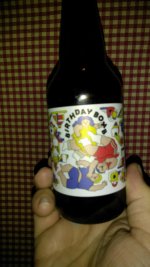inefficient use of a foodstuff. sorghum vodka rules!potato vodka
Errata on post a few days back the Polish potato vodka should be spelled Luksusowa - but of course the experts already knew that
As luck would have it, there's a bottle of that in the wife's bar. Think I'll have to make a White Russian after dinner.

jeff
Prairie Artisan Ales, "Birthday Bomb"
Imperial stout aged on Coffee, Cacao nibs, Vanilla beans, and Chili peppers.
MMMMMMM
https://www.diyaudio.com/forums/attachment.php?attachmentid=725151&stc=1&d=1546040773
Imperial stout aged on Coffee, Cacao nibs, Vanilla beans, and Chili peppers.
MMMMMMM
https://www.diyaudio.com/forums/attachment.php?attachmentid=725151&stc=1&d=1546040773
Attachments
Last edited:
inefficient use of a foodstuff. sorghum vodka rules!
Hej guys! Vodka made of anything but grain is like beef mad of anything but cow.
Actually, the internet tells me that “ any foodstuff that contains sugar or starch” including grains such as sorghum, corn, rice, rye, rye - either alone or in blends thereof (Sheringham) - or even hemp (Victoria Distillers) that can be fermented to produce the raw ethanol stock (approx 16% before distillation) will work. The key is that the ethanol be of agricultural origin.
What Is Vodka Made From? | Alcohol Fermentation
FWIW, having recently visited both the Victoria and Sheringham Distillers for tours and tastings twice now, I’m quite familiar with several of their products enunciated above, but also note that both Peter Hunt and Jason MacIsaac would attest that the purity of the water used to reduce the final distillate from 96% ABV to the normal 40% plays more than just a minor part.
What Is Vodka Made From? | Alcohol Fermentation
FWIW, having recently visited both the Victoria and Sheringham Distillers for tours and tastings twice now, I’m quite familiar with several of their products enunciated above, but also note that both Peter Hunt and Jason MacIsaac would attest that the purity of the water used to reduce the final distillate from 96% ABV to the normal 40% plays more than just a minor part.
I think the EU parliament let the vodka definition free. In many countries beer is just malt, water, hops and yeast, wine is nothing but grape juice. But in France wine can be sweetened, tinted have various chemicals and alcohol added and stll call it wine. The Belgian Kriek is cider more or less.
Tried the Mead yesterday, it was fermented to around 14%, spiced with really good quality apple juice and aniseed.
It's been outside for a while, and after some ice removal it's ca 18%.
Tastes and smells fresh like spring. flowers and bees, makes vivid images in my head of an apple tree filled with blossoms.
Much better than what they have at Vinmonopolet (government controlled liquor store), which is way too sweet and will most certainly get you hung over.
The Vikings used honey to make Mead not to make it sweet, but to get a strong brew and also for variation. The monks misunderstood the concept when Christianity took over this country, and many of the "modernized" (after ca 980-1050AD) recipes are heavily influenced by dark beer and spiritus production techniques. Calling for reductions, or double amount of honey, to heighten sugar contents, and heavy spice flavors to lessen the impact of the overly sweet brew.
Mead in it's simplest form is honey, diluted in water and fermented.
It's been outside for a while, and after some ice removal it's ca 18%.
Tastes and smells fresh like spring. flowers and bees, makes vivid images in my head of an apple tree filled with blossoms.
Much better than what they have at Vinmonopolet (government controlled liquor store), which is way too sweet and will most certainly get you hung over.
The Vikings used honey to make Mead not to make it sweet, but to get a strong brew and also for variation. The monks misunderstood the concept when Christianity took over this country, and many of the "modernized" (after ca 980-1050AD) recipes are heavily influenced by dark beer and spiritus production techniques. Calling for reductions, or double amount of honey, to heighten sugar contents, and heavy spice flavors to lessen the impact of the overly sweet brew.
Mead in it's simplest form is honey, diluted in water and fermented.
Stash chamomile tea with a homemade muffin.
I remember Muffin the mule in the 1960's.
Muffin The Mule Theme Tune - History of the BBC - YouTube
- Home
- Member Areas
- The Lounge
- What are you drinking?

